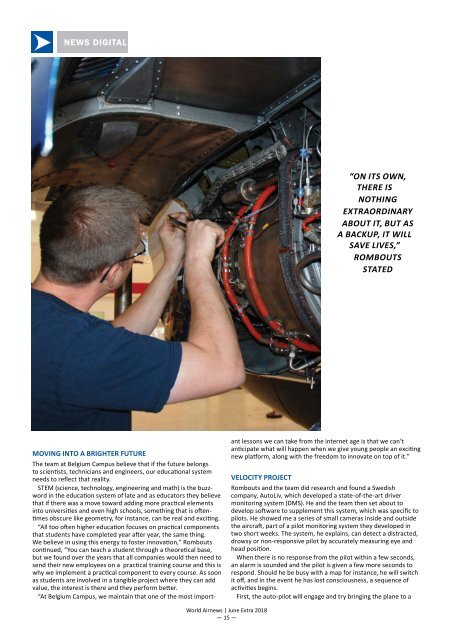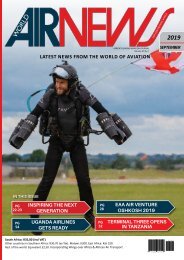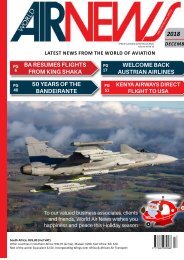World AirNews June 2018
- No tags were found...
You also want an ePaper? Increase the reach of your titles
YUMPU automatically turns print PDFs into web optimized ePapers that Google loves.
NEWS DIGITAL<br />
NEWS DIGITAL<br />
“on its own,<br />
there is<br />
nothing<br />
extrAordinAry<br />
ABout it, But As<br />
A BAckup, it will<br />
sAve lives,”<br />
romBouts<br />
stAted<br />
lower altitude to help the pilot regain consciousness, taking the<br />
terrain below into consideration. At the same time, with the GPS<br />
tracking of local towers and radios, a series of distress messages<br />
will be sent out on the radio waves, so that neighbouring pilots and<br />
air traffic control are aware of the situation.<br />
“This technology has been around for a long time and is used by<br />
commercial airliners,” he explains. “The trouble though, for the<br />
general aviation market, is it is not affordable. It was then that we<br />
decided to research the night vision systems utilised by top automobile<br />
brands around the world and found that AutoLiv was the<br />
manufacturer of these systems. It sent us a sample of the system<br />
and we are currently developing software for aircraft night vision.”<br />
Rombouts also stressed that while night vision was extremely<br />
important, what they would additionally be adding to the system<br />
was obstacle recognition for the runway, taking the centre line into<br />
consideration.<br />
Current GPS systems in general aviation aircraft will take you to<br />
a runway, within about two metres. However, these systems do<br />
not give accurate height readings in poor weather conditions. The<br />
height of an aircraft is measured by a barometer and the readings<br />
given by the older technology in sports aircraft and private<br />
planes, do not always accurately measure the current atmospheric<br />
pressure. “This sounds minor, but small differences can result in a<br />
massive differentiation,” Rombouts pointed out. “You may think<br />
you are 30 metres above the ground based on the readings you are<br />
given, but could be a few centimetres from the ground and crash.”<br />
HOW IT WORKS<br />
In an effort to increase safety on such aircraft, they are developing<br />
a small radar that from 40 metres above the ground, can measure<br />
precisely to 1 centimetre of an aircraft’s position. This is an<br />
important safety addition for landing in bad weather or at night, as<br />
the radar will pinpoint exactly where the plane is in relation to the<br />
ground.<br />
Rombouts explained that these were systems already in existence<br />
for commercial aviation, but due to the exorbitant costs of<br />
attaining them, very few aircraft in the general aviation sector have<br />
them.<br />
“We have now made it affordable and accessible and you’re looking<br />
at a lifesaving piece of equipment that will cost private pilots<br />
around $500,” he added.<br />
AUTOMATED PRE-FLIGHT CHECKLIST<br />
Every pilot usually works with a pre-flight checklist. In a<br />
commercial plane, the co-pilot assists the pilot through the list,<br />
while in general aviation, there is no co-pilot. So, the moment the<br />
pilot is reading through his checklist, he is not flying or looking at<br />
his instruments.<br />
No trouble for the students at Belgium Campus. Their ingenious<br />
minds created a mobile app whereby the pilot connects his phone<br />
to the audio panel and the pre-flight inspection is read out loud as<br />
he checks off each item on his yoke. The list can be modified to the<br />
pilot’s needs as each aircraft is different.<br />
“This is a simple piece of technology that doesn’t exist in general<br />
aviation today, but something that can reduce the workload of the<br />
pilot and in turn increase safety,” Rombouts highlights.<br />
The app has additional benefits when it comes to fuel mismanagement,<br />
one of the top four causes of aircraft engine failures.<br />
Most aircraft carry fuel in their wings, with valves to switch off flow<br />
of fuel in each wing to balance the plane. Theoretically, you have to<br />
switch your fuel flow from left to right or right to left, every twenty<br />
minutes. If the pilot is distracted by bad weather or simply forgets<br />
to switch between the two, the typical aircraft provides minimal<br />
warning of impending fuel exhaustion and it only takes a moment<br />
for the engine to stall when one tank has run empty.<br />
This is a typical accident cause because by the time the pilot<br />
switches tanks after the stall, and gets the motor back up and<br />
running, the plane cannot recover at a low altitude and crashes.<br />
On the app and software developed by his students, you can place<br />
sequences inside to remind the pilot through the audio panel of<br />
something as simple as switching fuel tanks.<br />
FULL DIGITAL AND BACKUP THROTTLE<br />
In the majority of aircraft, the engine is in the front of the plane,<br />
and from the cockpit to the throttle, you have a short cable.<br />
In planes with engines in the back, you have a long line of cable<br />
that weaves through the aircraft mainframe, bending and curving<br />
until it reaches the cockpit. When these cables snap, jam and<br />
break, they leave the pilot with a dramatic loss of control of the<br />
aircraft.<br />
While they were developing a digital throttle to improve on the<br />
safety of a cabled throttle, the students realised there were other<br />
factors at play that could decrease safety, namely, a short circuit in<br />
the server or if the battery ran out of power. They went back to the<br />
proverbial drawing board and developed a backup throttle system<br />
that runs off a completely different server and power source.<br />
The result is a throttle with a back-up that is activated by an actuator<br />
when one system fails.<br />
“On its own, there is nothing extraordinary about it, but as a<br />
backup, it will save lives,” Rombouts stated. Q<br />
MOVING INTO A BRIGHTER FUTURE<br />
The team at Belgium Campus believe that if the future belongs<br />
to scientists, technicians and engineers, our educational system<br />
needs to reflect that reality.<br />
STEM (science, technology, engineering and math) is the buzzword<br />
in the education system of late and as educators they believe<br />
that if there was a move toward adding more practical elements<br />
into universities and even high schools, something that is oftentimes<br />
obscure like geometry, for instance, can be real and exciting.<br />
“All too often higher education focuses on practical components<br />
that students have completed year after year, the same thing.<br />
We believe in using this energy to foster innovation,” Rombouts<br />
continued, “You can teach a student through a theoretical base,<br />
but we found over the years that all companies would then need to<br />
send their new employees on a practical training course and this is<br />
why we implement a practical component to every course. As soon<br />
as students are involved in a tangible project where they can add<br />
value, the interest is there and they perform better.<br />
“At Belgium Campus, we maintain that one of the most important<br />
lessons we can take from the internet age is that we can’t<br />
anticipate what will happen when we give young people an exciting<br />
new platform, along with the freedom to innovate on top of it.”<br />
VELOCITY PROJECT<br />
Rombouts and the team did research and found a Swedish<br />
company, AutoLiv, which developed a state-of-the-art driver<br />
monitoring system (DMS). He and the team then set about to<br />
develop software to supplement this system, which was specific to<br />
pilots. He showed me a series of small cameras inside and outside<br />
the aircraft, part of a pilot monitoring system they developed in<br />
two short weeks. The system, he explains, can detect a distracted,<br />
drowsy or non-responsive pilot by accurately measuring eye and<br />
head position.<br />
When there is no response from the pilot within a few seconds,<br />
an alarm is sounded and the pilot is given a few more seconds to<br />
respond. Should he be busy with a map for instance, he will switch<br />
it off, and in the event he has lost consciousness, a sequence of<br />
activities begins.<br />
First, the auto-pilot will engage and try bringing the plane to a<br />
<strong>World</strong> Airnews | <strong>June</strong> Extra <strong>2018</strong><br />
— 15 —<br />
<strong>World</strong> Airnews | <strong>June</strong> Extra <strong>2018</strong><br />
— 16 —





